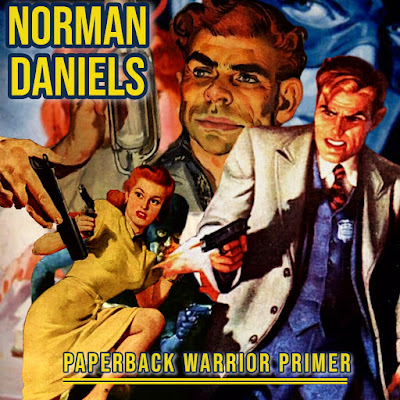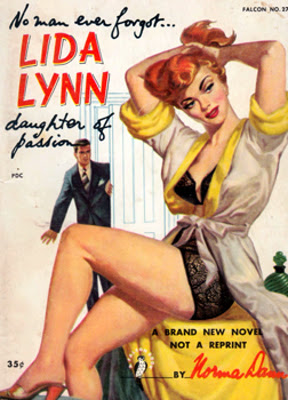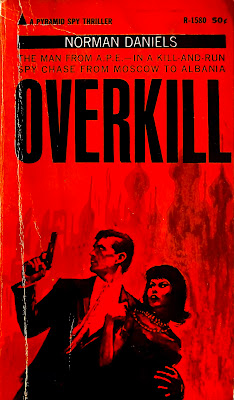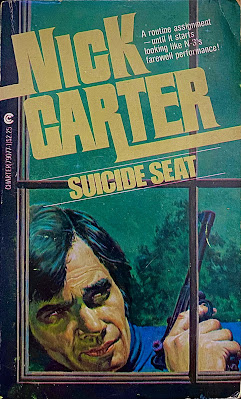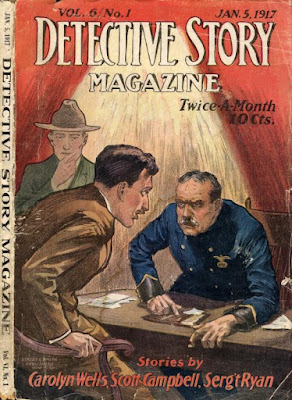The following article appears in the Afterword of the Brash Books edition of the 1973 hard-hitting vigilante novel The Revenger. I wrote this to commemorate not only this series but also Messmann's long and lasting body of work. I hope you enjoy it. - Eric Compton"Jon Messmann: Vengeance is Mine"
It's a human flaw, either well-conceived or spontaneous, and often is devoid of any real sense of right and wrong. This reactionary process, often spawned by grief and anger, makes it a swinging pendulum that authors can use to transform characters and enthrall readers. This reliable character arc can spur a story into a tumultuous second or third act. The thrills arise from the metamorphosis as the character changes and responds to some sort of emotionally jarring or horrific event.
The concept has remained a steady, consistent staple of literature dating back to ancient Greek tragedies of the 5th century BC. It consumes the third play of the Oresteia trilogy as Clytemnestra kills her husband Agamemnon for the sacrificial murder of their daughter. This sets off a chain of events in which Clytemnestra's remaining children plot to kill her to avenge the death of their father. A compelling, awe-inspiring cycle of violence as family matters turn to splatters.
William Shakespeare's longest play, The Tragedy of Hamlet, Prince of Denmark, is perhaps the epitome of revenge tales. Written between 1599 and 1601, the play's central theme is vengeance – served cold and calculated. Hamlet's dead father appears and explains that Claudius murdered him, thus fueling a desire for revenge. Thankfully, it became a rather complicated, emotional murder plot that propelled the play to eternal popularity.
Fast-forward to the 20th century's Western fiction and the classic revenge story becomes a familiar genre trope. Respected author Frank Gruber (1904-1969) codified the Western plots and includes revenge as one of seven basic plots. Gruber described the revenge story as the pursuit of a villain by an individual he wronged, but mentions that it also could involve elements of the classic mystery story. The protagonist's southern drawl can be heard to say something like, “you're the dirty rascal that shot my pa” or “the bastard had it coming.”

In men's action-adventure literature, the undisputed catalyst for the 1970s-1990s vigilante heyday is War Against the Mafia. It was authored by Don Pendleton and originally purchased by Bee Line, who then published the book in 1969 under a subsidiary called Pinnacle Books. In the novel, Sergeant Mack Bolan is serving as a U.S. Army sniper in the Vietnam War. With 97 confirmed kills, he earns the bleak moniker, The Executioner. Unlike the decades of vengeance tales before it, Pendleton incorporated a murder-suicide into the character arc. Bolan's sister and father became financially controlled by the Mafia. The stress and financial burdens provoked Bolan's father into killing his wife and daughter before committing suicide. Bolan learns of the deaths and flies home, never to return to the military. Instead, he becomes a one-man army to exact revenge on the Mob. In essence, it is the classic revenge story modernized.

Beginning in 1970, countless publishers wanted to create another Mack Bolan clone to capture the same success that Pinnacle was experiencing. The Executioner directly influenced countless novels, series titles and publisher demands for more revenge stories with a gritty, violent delivery. Like the pulps of the 1930s and 1940s, these titles needed a tragic origin story to propel the hero into action. Publishers, desperately wanting The Executioner readers and consumers to gravitate toward their titles, pitched their ideas and marketing designs to a revolving door of blue collar, working man authors. Along with the look and feel of a vigilante story, the publishers (including Pinnacle and Gold Eagle) created names for their heroes that sounded similar to the word “Executioner” - Butcher, Terminator, Avenger, Hawker, Dagger, Penetrator, Enforcer, Sharpshooter, Stryker, Ryker, Keller, Peacemaker, Liquidator, Inquisitor. Even Marvel Comics received permission from Pendleton to clone Bolan as The Punisher, one of their most consistently selling comic titles of the last 50 years. Obviously, the prerequisite for any proposed paperback warrior was that the title had to end in the letter R.
Or, in some cases begin and end with that letter. Like, The Revenger.
John Joseph Messmann created The Revenger series in 1973 for publisher Signet, then a division of New American Library. But, Messmann's path to vigilante fiction was the proverbial long and winding road. Born in 1920, Messmann began his artistic career by playing the violin, an extracurricular activity forced on him by his parents. By 1940, Messmann began writing for the up-and-coming comic industry, a period known as the Golden Age of Comic Books. His first gig was for Fawcett Comics, an early, successful comic book publisher of that era. His co-workers were a dream-team of comic book icons including Joe Simon, Jack Kirby, and Chic Stone. Messman wrote for a decade on titles like Captain Marvel Jr., Human Torch, Sub-Mariner, Gabby Hayes, Don Winslow of the Navy, Tex Ritter, and Nyoka: The Jungle Girl. He even created a comic strip technique as an education program conducted for the United Nations Information Office.In 1950, Messmann, now using Jon J. Messmann, co-created Carousel, an 8-page tabloid comics section in the Pittsburg Courier. This featured many of Messmann's ideas including secret agents, historical romance, sea adventure, private-eyes, jungle girls and even fairy tales. Carousel lasted five years and was distributed by New York's Smith-Mann Syndicate. Over time, Messmann was no longer content with the comic industry.
Beginning in the 1960s, Messmann’s transition into paperback, full-length novels began with Lyle Kenyon Engel’s star franchise, Nick Carter: Killmaster. Messmann’s first contribution was the series' 37th installment, 14 Seconds to Hell, published in 1968. The series, authored by a selection of ghost writers under the name Nick Carter, was a firm stepping stone for Messmann. The series paralleled the pulp industry in terms of campy, over-the-top secret-agent action. Messmann’s experience writing comics and comic strips made him a useful workhorse for Engel to rely upon. The author contributed 14 more installments through 1970 before departing the series.

It was just a matter of time before publishing trends would align with Messmann’s literary strengths. His experience in spy-fiction, Gothics, and action-adventure is a product of that era. Genre fiction was consistently reliable for publishers and there were plenty of ideas, authors, and healthy competition. After The Executioner began to develop banner sales numbers for Pinnacle, it was only fitting that Messmann made his own vigilante footprint. In 1973, The Revenger was born.
It’s a mystery on who originally had the idea for Ben Martin, the former military veteran turned Mafia buster. It could be that Messmann had read Don Pendleton and wanted to try his hand or Signet simply approached Messmann’s agent about the story and needed an experienced writer to tell it. By 1973, Messmann had authored books for Award, Fawcett Gold Medal, Belmont-Tower, and Pyramid. He never played hard to get and had a knack for the business dating back 30 years at that point. With the key words “personal tragedy”, “vengeance”, “hero”, “violence”, “sex”, Messmann’s typewriter lit up with possibilities.

When Messmann introduces Martin, he is an honest living, blue-collar family man who owns a grocery store. His nights of silently awaiting targets in a muddy rice paddy are over. But after the character arc, Messmann is transformed from shop owner back into the prowling warrior. By the book’s fiery finale, he’s either alive or dead. Messmann creates this stirring character arc that feeds off of a very personal tragedy. Like Pendleton’s Mack Bolan origin story, it isn’t a straight-up, traditional “you shot up my family” vendetta. In fact, the tragedy is an accident - caused by evil men - but still an accident. Whether anyone would have died otherwise is in the eye of the beholder. But, Martin’s life is deeply affected, and revenge is the only recourse. In these novels, revenge is always the only recourse. Thus, The Revenger rises.
By the end of the bloodshed, the supposed end of Martin’s war, readers are left to arrive at their own conclusions. Why? The Revenger wasn’t planned as a series. There’s nothing to indicate that Signet had any other plans for Messmann or Ben Martin. The paperback's spine, front and back covers and last pages are devoid of anything suggesting this is a series debut. But, it was. Only Signet and Messmann didn’t know it.

As you read and enjoy The Revenger series, a clear genre standout, take note of Messmann’s special treatment of Martin’s psyche. With an uncanny awareness, he delves into Martin’s warrior soul and deciphers dark emotions for the reader. In many ways, Martin could be the most complex vigilante in terms of repressed feelings and temperament. In the second installment, Martin becomes the vigilante, but he doesn’t really want that burden. He dreams of the life that once was, an existence robbed from him by events outside of his control. The old adage “when you look back, it will be what you’ve overcome” is a staple of Martin’s forward outlook, but it’s a reminder of the scars. In reality, Martin realizes that he’s the blood-craving vampire, only it’s revenge that fuels his existence. The emotion makes him alive and whole, ultimately the reason to rise and exist each day. After nights as a sniper in Vietnam, the ongoing war with the mob, and his transformation into a family man, Martin realizes he’s destined to right the wrongs and be the killer of evil. It was the one constant in his life.

By 1978, adult Western fiction rose to prominence and was led by a series heavyweight in Lou Cameron's Longarm. The concept was simply to incorporate two to three graphic sex scenes into a traditional western paperback. The main character fights the bad guys and pleases the bad girls. Messmann, following the trend, created The Trailsman series in 1980 for Signet. Like Don Pendleton's The Executioner, Messmann birthed an iconic hero in Skye Fargo – lake blue eyes and bed mattress Olympian – and placed him in nearly 400 total installments. Of those, Messmann wrote nearly half up until his retirement in 1998, a testament to his storytelling skills and craftsmanship.
It was rumored that Messmann had never been to the western regions of the U.S., instead writing every Trailsman novel from the comfort of his Manhattan apartment. He would later die at the age of 84 in a New York nursing home in 2004.
New York Times bestselling author Lee Goldberg and his Brash Books imprint have been doing God’s work for years by reprinting and reintroducing classic novels by forgotten talented authors for modern audiences. Thankfully, Jon Messmann’s stellar body of work has been recognized and included in the publisher’s superb lineup of novels and collections. I can’t think of a more deserving author than Jon Messmann. I also feel that if he were alive today, he would already be writing a new series of heroic fiction for Goldberg and pitching character concepts for another.
The greats like Jon Messmann never ran out of ideas — they just ran out of time.
01/29/2022
Eric Compton
Paperback Warrior
Jon Messmann - Partial Bibliography
As Nick Carter:Nick Carter: Killmaster #39 Carnival for Killing 1969 (Award Books)Nick Carter: Killmaster #43 The Amazon 1969 (Award Books)Nick Carter: Killmaster #44 The Sea Trap 1969 (Award Books)Nick Carter: Killmaster #45 Berlin 1969 (Award Books)Nick Carter: Killmaster #48 The Living Death 1969 (Award Books)Nick Carter: Killmaster #49 Operation Che Guevara 1969 (Award Books)Nick Carter: Killmaster #50 The Doomsday Formula 1969 (Award Books)Nick Carter: Killmaster #51 Operation Snake 1969 (Award Books)Nick Carter: Killmaster #52 The Casbah Killers 1969 (Award Books)Nick Carter: Killmaster #53 The Arab Plague 1970 (Award Books)Nick Carter: Killmaster #54 Red Rebellion 1970 (Award Books)Nick Carter: Killmaster #55 The Executioners 1970 (Award Books)Nick Carter: Killmaster #57 Mind Killers 1970 (Award Books)Nick Carter: Killmaster #60 The Death Strain 1970 (Award Books) Nick Carter: Killmaster #37 14 Seconds to Hell 1968 (Award Books)
As Claudette Nicole:
Bloodroots Manor 1970 (Fawcett Gold Medal)
The Mistress of Orion Hall 1970 (Fawcett Gold Medal)
House at Hawk's End 1971 (Fawcett Gold Medal)
Circle of Secrets 1972 (Fawcett Gold Medal)
The Dark Mill 1972 (Fawcett Gold Medal)
The Haunted Heart 1972 (Pyramid)
The Chinese Letter 1973 (Popular Library)
The Haunting of Drumroe 1973 (Fawcett Gold Medal)
When the Wind Cries 1976 (Pyramid)
As Pamela Windsor:
Forsaking All Others 1977 (Jove)
Rebel's Rapture 1979 (Jove)
At Passion's Tide 1980 (Jove)
Jefferson Boone: Handyman
The Moneta Papers 1973 (Pyramid)
The Game of Terror 1973 (Pyramid)
Murder Today, Money Tomorrow 1973 (Pyramid)
The Swiss Secret 1974 (Pyramid)
Ransom! 1975 (Pyramid)
The Inheritors 1975 (Pyramid)
Canyon 'O Grady series (as Jon Sharpe)
Dead Men's Trails 1989 (Signet)
Silver Slaughter 1989 (Signet)
Shadow Guns 1989 (Signet)
The Revenger:
The Revenger 1973 (Signet)
Fire in the Streets 1974 (Signet)
The Vendetta Contract 1974 (Signet)
The Stiletto Signature 1974 (Signet)
City for Sale 1975 (Signet)
A Promise for Death 1975 (Signet)
Hot Line (as Paul Richards):
Our Spacecraft is Missing! (with George Snyder) 1970 (Award Books)
Logan (as Alan Joseph):
Logan 1970 (Belmont)
Killers at Sea 1970 (Belmont)
Stand-Alone titles:
The Deadly Deep 1976 (New Amerian Librery)
Phone Call 1979 (Signet)
Jogger's Moon (aka To Kill a Jogger) 1980 (Penguin)
The Last Snow 1989 (Random House)
A Bullet for the Bride 1972 (Pyramid)
Non-Fiction:
Choosing a Pet 1973 Grosset & Dunlap
Comics:
Don Winslow of the Navy 1940-1951
Gabby Hayes 1940-1949
Human Torch 1943
Sub-Mariner 1943
Nyoka: The Jungle Girl #50 1945
Tex Ritter 1950
Captain Marvel Jr. 1940-1949

